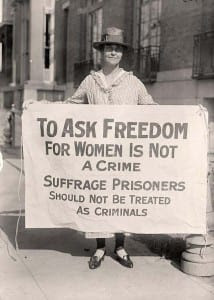Thursday, November 17, 2022 – WE FORGET WHAT EFFORTS IT TOOK FOR WOMEN TO GET THE VOTE


FROM THE ARCHIVES
THURSDAY, NOVEMBER 15, 2022
ISSUE # 836
TODAY IN WOMENS RIGHTS HISTORY:
NIGHT OF TERROR
NEW YORK ALMANACK
Women’s Rights History: ‘The
Night Of Terror’
November 14, 2022 by Editorial Staff

The Silent Sentinels, or Sentinels of Liberty, organized by Alice Paul and the National Woman’s Party, were a group of over 2,000 women demanding women’s suffrage by silently protesting in front of the White House during Woodrow Wilson’s presidency beginning on January 10, 1917. About 500 were arrested, with at least 168 serving jail time – many of them from New York State, a birthplace of the suffrage and women’s rights movements.
Over the two and a half year long protest many of the women who picketed were arrested, harassed and abused by local and federal authorities, most notably being tortured while in local jails. Among the most horrific of these acts occurred during the night of November 14-15, 1917, known as the Night of Terror.
The conditions of the District of Columbia Jail were unsanitary and unsafe, with prisoners sharing cells and prison facilities with people who had syphilis and other communicable diseases, and where worms were often found in the food. When those arrested surpassed the number of spaces at the DC Jail, the women being arrested were taken to Virginia’s Occoquan Workhouse (now the Lorton Correctional Complex, in Lorton Virginia).
The conditions at the Occoquan Workhouse were terrible. Ordered to strip naked and bathe with a single bar of soap, the women refused.
During a suffrage debate in a committee of the House of Representatives in September 1917, Massachusetts Representative Joseph Walsh called suffragist “nagging… iron-jawed angels,” who were “bewildered, deluded creatures with short skirts and short hair.”

The protests continued, and sentences to jail grew longer. On October 20, 1917, Alice Paul was arrested while carrying a banner that said: “The time has come to conquer or submit, for us there can be but one choice. We have made it.” The banner language was a direct quote of President Woodrow Wilson.
Paul was sentenced to seven months. She was put in solitary confinement for two weeks, with only bread and water. She became weak and unable to walk, and began a hunger strike after being taken to the prison medical ward. In response to the hunger strike, the prison doctors force-fed the women who joined her by forcing tubes down their throats.
A large number of woman protested this treatment on November 10th and about 3o women were arrested and sent to Occoquan Workhouse. On the night of November 14th, the superintendent, W.H. Whittaker, ordered some forty guards to brutalize the suffragists. They beat New Yorker Lucy Burns, chained her hands to the cell bars above her head, then left her there for the night. They put Dora Lewis into a dark cell and smashed her head against an iron bed, knocking her unconscious. Her cellmate, Alice Cosu, who believed Lewis to be dead, suffered a heart attack. Guards dragged, beat, choked, pinched, and kicked other women.
A total of 14 women from New York State were among a larger group of abused protestors. A significant number of New Yorkers also provided support on the White House picket line from January 1917 through June of 1918.
Suffragists themselves called the night the “Night of Terror.” The attack on activists within the correctional facility and the subsequent extensive nationwide publicity became a turning point in the national effort to win votes for women. The campaign for voting rights goes back to the 1848 women’s rights convention in Seneca Falls, NY and ends with the ratification of the 19th Amendment to the U.S. Constitution in August of 1920.
New York State conducted two referendums on the “votes for women” issue in 1915 and then again in 1917. The 1917 New York State victory recharged the national suffrage movement. After 1917, New York’s large population of new women voters effectively doubled the number of women voters in the nation. The New York victory represented a major step forward in bringing the national suffrage issue to a conclusion in 1920.

New York women arrest for “unlawful assembly” and sentenced on November 14, 1917 included:
- Amy Juengling, Buffalo, NY
- Hattie Kruger, Buffalo, NY
- Paula Jacobi, NYC
- Eunice Brannan, NYC
- Lucy Burns, NYC
- Emily Dubois Butterworth, NYC
- Dorothy Day, NYC
- Elizabeth Hamilton, NYC
- Louise Hornsby, NYC
- Peggy Johns, NYC
- Kathryn Lincoln, NYC
- Belle Sheinberg, NYC
- Cora Week, NYC
- Matilda Young, NYC
The Turning Point Suffragist Memorial Memorial, near the “Night of Terror” site in Lorton, Virginia, honors the women who were imprisoned at the Occoquan Workhouse and commemorates all of the millions of little-known women who engaged in the suffragist movement primarily from 1848 through passage of the 19th Amendment in 1920 with which most women won the right to vote. More information is available at http://www.suffragistmemorial.org
Thursday Photo of the Day
SEND YOUR ANSWER TO:
ROOSEVELTISLANDHISTORY@GMAIL.COM

WEDNESDAY PHOTO OF THE DAY
THE ANSONIA HOTEL
HARA REISER, ANDT SPARBERG, ALEXIS VILLAFANE, THOM HEYER, ARON EISENPREISS GOT IT RIGHT!

Text by Judith Berdy
Thanks to Bobbie Slonevsky for her dedication to Blackwell’s Almanac and the RIHS
Thanks to Deborah Dorff for maintaining our website
Edited by Melanie Colter and Deborah Dorff
All image are copyrighted (c) Roosevelt Island Historical Society unless otherwise indicated
Sources
NEW YORK ALMANACK
THIS PUBLICATION FUNDED BY DISCRETIONARY FUNDS FROM CITY COUNCIL MEMBER JULIE MENIN & ROOSEVELT ISLAND OPERATING CORPORATION PUBLIC PURPOSE FUNDS.


Copyright © 2022 Roosevelt Island Historical Society, All rights reserved.Our mailing address is:
rooseveltislandhistory@gmail.com

Leave a comment